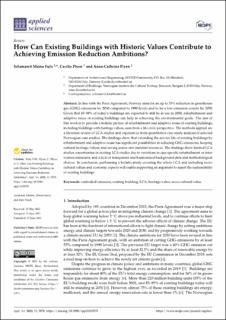How Can Existing Buildings with Historic Values Contribute to Achieving Emission Reduction Ambitions?
Peer reviewed, Journal article
Published version
Date
2021Metadata
Show full item recordCollections
- Publikasjoner fra CRIStin - SINTEF AS [5801]
- SINTEF Community [2247]
Abstract
In line with the Paris Agreement, Norway aims for an up to 55% reduction in greenhouse gas (GHG) emissions by 2030 compared to 1990 levels and to be a low-emission society by 2050. Given that 85–90% of today’s buildings are expected to still be in use in 2050, refurbishment and adaptive reuse of existing buildings can help in achieving the environmental goals. The aim of this work is to provide a holistic picture of refurbishment and adaptive reuse of existing buildings, including buildings with heritage values, seen from a life cycle perspective. The methods applied are a literature review of LCA studies and experiences from quantitative case study analysis of selected Norwegian case studies. The findings show that extending the service life of existing buildings by refurbishment and adaptive reuse has significant possibilities in reducing GHG emissions, keeping cultural heritage values, and saving scarce raw material resources. The findings show limited LCA studies, uncertainties in existing LCA studies due to variations in case-specific refurbishment or intervention measures, and a lack of transparent and harmonized background data and methodological choices. In conclusion, performing a holistic study covering the whole LCA and including sociocultural values and economic aspects will enable supporting an argument to assert the sustainability of existing buildings.
Publisher
MDPIJournal
Applied SciencesCopyright
© 2021 The authors© 2021 The authors
